See also
| This disambiguation page lists articles associated with the title Knitting. If an internal link led you here, you may wish to change the link to point directly to the intended article. |
Knitting is a method by which yarn is turned into fabric.
Knit, knitted, or knitting may also refer to:
| This disambiguation page lists articles associated with the title Knitting. If an internal link led you here, you may wish to change the link to point directly to the intended article. |

Knitting is a method by which yarn is manipulated to create a textile or fabric; it is used in many types of garments. Knitting may be done by hand or by machine.
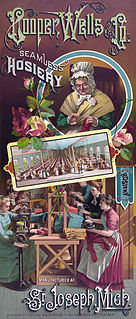
Hosiery, also referred to as legwear, describes garments worn directly on the feet and legs. The term originated as the collective term for products of which a maker or seller is termed a hosier; and those products are also known generically as hose. The term is also used for all types of knitted fabric, and its thickness and weight is defined by denier or opacity. Lower denier measurements of 5 to 15 describe a hose which may be sheer in appearance, whereas styles of 40 and above are dense, with little to no light able to come through on 100 denier items.

A knitting needle or knitting pin is a tool in hand-knitting to produce knitted fabrics. They generally have a long shaft and taper at their end, but they are not nearly as sharp as sewing needles. Their purpose is two-fold. The long shaft holds the active (unsecured) stitches of the fabric, to prevent them from unravelling, whereas the tapered ends are used to form new stitches. Most commonly, a new stitch is formed by inserting the tapered end through an active stitch, catching a loop of fresh yarn and drawing it through the stitch; this secures the initial stitch and forms a new active stitch in its place. In specialized forms of knitting the needle may be passed between active stitches being held on another needle, or indeed between/through inactive stitches that have been knit previously.

Knitting is the process of using two or more needles to loop yarn into a series of interconnected loops in order to create a finished garment or some other type of fabric. The word is derived from knot, thought to originate from the Dutch verb knutten, which is similar to the Old English cnyttan, “to knot”. Its origins lie in the basic human need for clothing for protection against the elements. More recently, hand knitting has become less a necessary skill and more a hobby.

Nålebinding is a fabric creation technique predating both knitting and crochet. Also known in English as "knotless netting," "knotless knitting," or "single needle knitting," the technique is distinct from crochet in that it involves passing the full length of the working thread through each loop, unlike crochet where the work is formed only of loops, never involving the free end. It also differs from knitting in that lengths must be pieced together during the process of nålebinding, rather than a continuous strand of yarn that can easily be pulled out. Archaeological specimens of fabric made by nålebinding can be difficult to distinguish from knitted fabric.
Combined knitting or combination knitting is a style that combines elements of Eastern-style knitting with the Western techniques. The name was suggested by Mary Thomas in her 1938 book "Mary Thomas's Knitting Book", where she described the technique as "..the better way to work in Flat Knitting. The resulting fabric is more even and closer in construction." By wrapping the yarn the opposite way while purling, the knitter changes the orientation of the resulting loops; then the next row's knit stitches can be formed by inserting the needle through the back leg, rather than through the front leg, without twisting the stitch. This technique is suitable for all knitted fabrics from the basic Stockinette stitch, to any other style, such as Fair Isle, circular knitting, or lace knitting.

A knitting machine is a device used to create knitted fabrics in a semi or fully automated fashion.

Cable knitting is a style of knitting in which textures of crossing layers are achieved by permuting stitches. For example, given four stitches appearing on the needle in the order ABCD, one might cross the first two the next two, so that in subsequent rows those stitches appear in the new order CDAB.
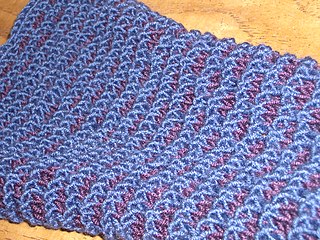
Slip-stitch knitting is a family of knitting techniques that use slip stitches to make multiple fabrics simultaneously, to make extra-long stitches, and/or to carry over colors from an earlier row.
Knitting abbreviations are often used for brevity in describing knitting patterns.
In knitting, weaving is a family of techniques used for several purposes in knitting.
Basic knitted fabrics include stockinette stitch, reverse stockinette stitch, garter stitch, seed stitch, faggoting, and tricot. In some cases, these fabrics appear differently on the right side than on the wrong side.
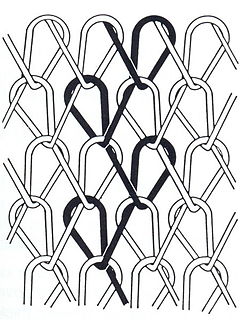
Warp knitting is a family of knitting methods in which the yarn zigzags along the length of the fabric; i.e., following adjacent columns, or wales, of knitting, rather than a single row, or course. For comparison, knitting across the width of the fabric is called weft knitting.
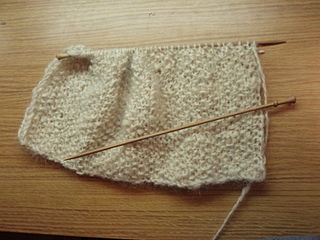
Flat knitting is a method for producing knitted fabrics in which the work is turned periodically, i.e., the fabric is worked with alternating sides facing the knitter. Another method of reaching the same result is to knit alternately from right to left and left to right without turning; this back-and-forth technique requires either innate or learned ambidextrous motor skills. The two sides of the fabric are usually designated as the right side and the wrong side.
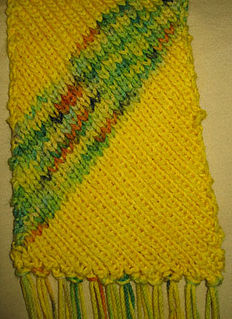
Bias knitting is where the rows of a fabric run diagonally, instead of horizontally.
A hem in knitting is the edge of a piece of knitted fabric that is parallel to the rows of stitches, as compared to a selvage, which is perpendicular to the hem and rows of stitches. Hems can be made in several ways.

Double knitting is a form of hand knitting in which two fabrics are knitted simultaneously on one pair of needles. The fabrics may be inseparable, as in interlock knitted fabrics, or they can simply be two unconnected fabrics. In principle, an arbitrary number of fabrics can be knitted simultaneously on one pair of knitting needles with yarns, as long as one is careful.
Knitted fabric is a textile that results from knitting. Its properties are distinct from woven fabric in that it is more flexible and can be more readily constructed into smaller pieces, making it ideal for socks and hats.
Complete garment knitting is a next-generation form of fully fashioned knitting that adds the capability of making a 3-dimensional full garment. Unlike other fully fashioned knitting, where the shaped pieces must still be sewn together, finished complete knitted garments do not have seams. The knitting machines' computerized instructions direct movement of hundreds of needles to construct and connect several tubular knitted forms to create a complete garment in a single production step.
In knitting, the three needle bindoff is a method of joining two pieces of knitted fabric using three needles. One needle is on each piece of the fabric, and a third needle is used for the knitting.